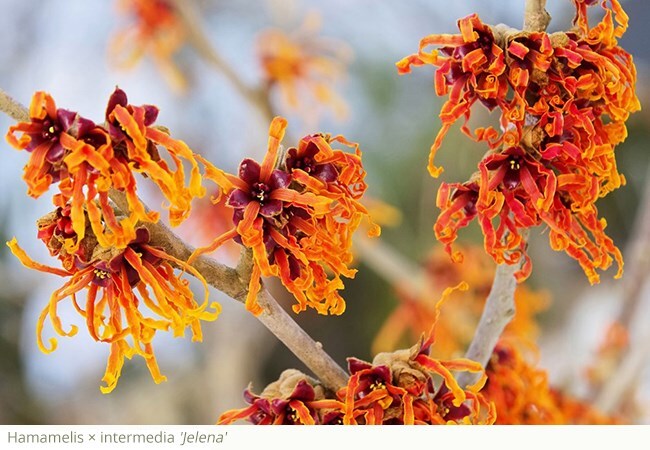When the year has turned, and the days are getting longer once again your garden should be stirring into life. That’s when we all need a dose of hedonistic winter fragrance from those early flowers, that will linger on the air on clement January afternoons whetting your appetite for the year ahead. Not only do they make a perfect posy for the kitchen table, but they're more than just pleasurable to our native bees.They are vital life savers for our early queen bees, which will need an instant source of pollen and nectar in order to raise this year's brood. For this reason alone every gardener should aspire to provide January flowers. They're good for the soul and good for the bee!
Indestructible, Desirable and Beguiling - the Witch Hazel
The most winter-rugged flowers of all are the witch hazels (named forms of Hamamelis) with their strands of ribbon-like petals that shrug off heavy rain, frost and snow without browning, or withering. The flowers come in marmalade shades, ranging from burnt-orange, to citrus-peel yellow, through to paprika-red. The ribbons form spiders that seem to cling to the bare, dark branches. Close up, these ribbons often nestle in colourful red cups (or calices) providing a crisp contrast to warm up any winter's day. Some also colour up well in autumn.
 Witch hazels span two continents in the wild, Asia and North America. When plant hunters introduced Asian species into America in the early years of the 20th century they hybridised with their American cousins to produce larger flowered hybrids now known as H. x intermedia. Some named forms were deliberately bred by enthusiasts like the de Belder family who developed Kalmthout Arboretum in Belgium. They often chose family names and they include the widely grown 'Jelena' (a non-scented russet-brown from 1954) and 'Diane' (a slightly scented deep-red from 1969). Witch hazels span two continents in the wild, Asia and North America. When plant hunters introduced Asian species into America in the early years of the 20th century they hybridised with their American cousins to produce larger flowered hybrids now known as H. x intermedia. Some named forms were deliberately bred by enthusiasts like the de Belder family who developed Kalmthout Arboretum in Belgium. They often chose family names and they include the widely grown 'Jelena' (a non-scented russet-brown from 1954) and 'Diane' (a slightly scented deep-red from 1969).
Others appeared by themselves and these include the mysterious 'Pallida', which was first spotted on Battleston Hill at RHS Wisley in the 1940s and was probably a seedling. 'Pallida' remains the best pale-yellow witch hazel to look at and it also has an extraordinary scent, reminiscent of freesias. Many witch hazels are scented, although not all, but their fragrance varies from medicinal, to toilet cleaner, to floral. The yellows tend to have more scent and 'Arnold Promise' (a late variety developed at the Arnold Arboretum in America in 1963) has lots of small yellow flowers with a sweet, strong scent - prefect for cutting and bringing indoors.
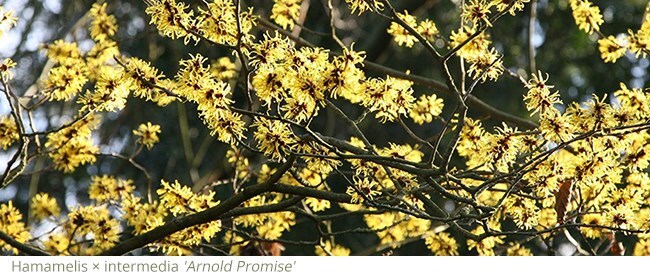
It's a popular misconception that witch hazels need acid-soil to thrive. They need good moisture-retentive soil, so won't thrive on chalk or thin soil. Other than that they do well on most. Like many plants with an Asian pedigree, or part pedigree, they need summer rainfall to emulate the rainy season. They also need good light to encourage next year's flower buds. They clearly signal their thirst in summer by turning their leaves to a vertical angle to slow down transpiration. This means they require water and lots of it. Gently tip two buckets over their roots and repeat this every time their foliage slants downwards.
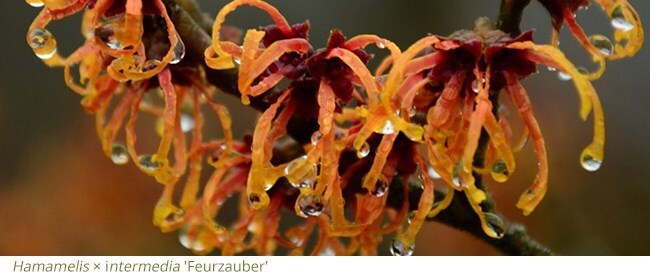
Witch hazels vary in shape and size, although they are all slow-growing and shrubby rather than tree-like. For this reason pruning is limited to a tidy after flowering, only if needed. Remove any crossing branches or damaged wood and tip back the leaders a little to promote more flower bud, if you wish. Buy your witch hazels now, when in flower, but keep them somewhere sheltered and plant them outside once spring arrives. They also do well in containers.
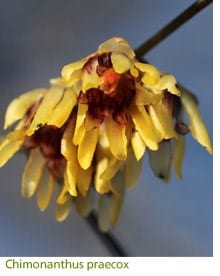 Generously Scented and Generously Proportioned Generously Scented and Generously Proportioned
The subtly-toned wintersweet (Chimonanthus praecox) is one of the most useful winter shrubs, producing almost translucent antique-yellow flowers warmed by a dash of blood-red. However this shrub needs a great deal of space and good light, taking up a 2m spread. Given both it will shine, although it has one bad habit. It's late to drop its foliage so if it's still clinging to a few last leaves pull them away gently so that the flowers, which look like ragged tutus on close inspection, can be seen to full advantage. This won't do any harm.
Being a Chinese shrub this needs summer moisture, so good soil is a necessity. Don't let size put you off either, for this twiggy winter shrub is one of the best for cut flowers. A few stems will scent a large room, but do try to give it a sheltered position because the gentle flowers can get damaged and browned by hard weather.
More Winter Flowers
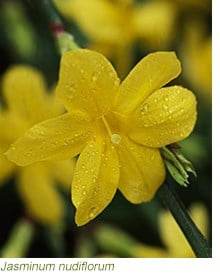 One of the brightest winter warmers is winter jasmine (Jasminum nudiflorum) and this versatile, hardy shrub can be tightly clipped against a wall, used to form an arch, or be allowed to flow over a low wall. It's easy and undemanding and the new olive-green wood makes a perfect foil for the bright-yellow starry flowers that open along the length of the stems, although sadly without any scent. If it's cut back after flowering and sited well, winter jasmine is one of the top winter performers and will provide fresh flowers from November until March. Pruning will promote new shiny stems, but if left alone (as many are) it will form a tangle of brown twigs with little flower. One of the brightest winter warmers is winter jasmine (Jasminum nudiflorum) and this versatile, hardy shrub can be tightly clipped against a wall, used to form an arch, or be allowed to flow over a low wall. It's easy and undemanding and the new olive-green wood makes a perfect foil for the bright-yellow starry flowers that open along the length of the stems, although sadly without any scent. If it's cut back after flowering and sited well, winter jasmine is one of the top winter performers and will provide fresh flowers from November until March. Pruning will promote new shiny stems, but if left alone (as many are) it will form a tangle of brown twigs with little flower.
Mahonias also offer yellow flowers and forms of Mahonia x media have prickly evergreen foliage that's topped by fountains of scented yellow flower. 'Winter Sun' has bright-yellow upright racemes and 'Charity' is a softer yellow. The upright, architectural shrubs can flower as early as November and both will perform in shade whilst keeping their rigid shape.
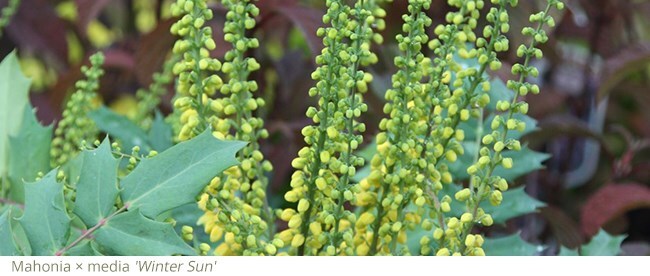
A Long Flowering Season and a Hyacinth Scent
 Many early-flowering deciduous viburnum are scented, with pink mopheads of small flowers that appear in patches throughout winter whenever the weather allows. One of the most scented of all is a medium to large shrub that's ubiquitous to most gardens because it's easy and needs no special treatment to flower well. Viburnum x bodnantense 'Dawn' is highly fragrant on damp winter days whether it's growing as a hedge, or a specimen shrub. Viburnum × bodnantense 'Charles Lamont', like ‘Dawn’has an RHS Award of Merit (AGM) attributed to it and is worthy of a mention. An upright deciduous shrub with clusters of bright pink, heavily scented flowers appear from November to March to fill the winter air. Plant where you can appreciate the wafting perfume on a winters day. Many early-flowering deciduous viburnum are scented, with pink mopheads of small flowers that appear in patches throughout winter whenever the weather allows. One of the most scented of all is a medium to large shrub that's ubiquitous to most gardens because it's easy and needs no special treatment to flower well. Viburnum x bodnantense 'Dawn' is highly fragrant on damp winter days whether it's growing as a hedge, or a specimen shrub. Viburnum × bodnantense 'Charles Lamont', like ‘Dawn’has an RHS Award of Merit (AGM) attributed to it and is worthy of a mention. An upright deciduous shrub with clusters of bright pink, heavily scented flowers appear from November to March to fill the winter air. Plant where you can appreciate the wafting perfume on a winters day.
Daphnes - Capricious Creatures with Charisma
Daphnes need a tender touch and they are rarely, if ever, pruned. They also have an annoying habit of suddenly fading away in full glory, yet they are still worth growing, for the heady scent of their flowers are completely intoxicating. The earliest to flower is a Himalayan species,
D. bholua, found on high mountain slopes where monsoon rains make summers wet and cool. Various collections have been made in the wild, some deciduous and some semi-evergreen. The deciduous ones are high altitude specialists and very hardy. The semi-evergreens are low-altitude and less so. In their native habitat winters are intensely cold, so these daphnes flower in late-spring. However our warmer climate prompts much earlier flower here.
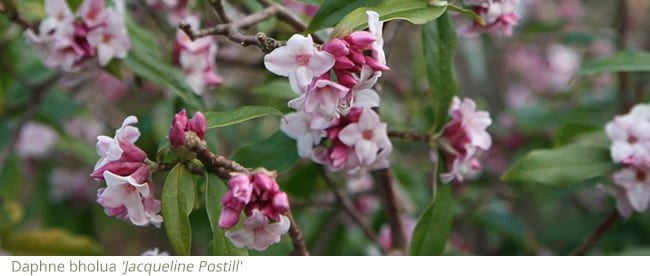 The most desirable form of D. bholua was not found in the wild however. It was a seedling raised from 'Gurkha' by Alan Postill of Hillier Nurseries. Generally semi-evergreen, but in severe winters it can drop all its leaves, it was nurtured by Alan Postill and named after his wife Jacqueline Postill 'becoming a 'must-have' garden classic. It forms a columnar bush with small sweetly scented mauve-pink flowers making it completely unique and irresistible between January and March. Plant it in a sunny, sheltered spot, by a path so you can enjoy the perfume and under-plant with something like Cyclamen coum. The most desirable form of D. bholua was not found in the wild however. It was a seedling raised from 'Gurkha' by Alan Postill of Hillier Nurseries. Generally semi-evergreen, but in severe winters it can drop all its leaves, it was nurtured by Alan Postill and named after his wife Jacqueline Postill 'becoming a 'must-have' garden classic. It forms a columnar bush with small sweetly scented mauve-pink flowers making it completely unique and irresistible between January and March. Plant it in a sunny, sheltered spot, by a path so you can enjoy the perfume and under-plant with something like Cyclamen coum.

Daphne odora, originating from Japan and China is a rounded compact evergreen shrub, with glossy green leaves adding form to your garden throughout the year, but the beauty is really when the prized purple-pink buds open to reveal their pale pink petals. Gloriously scented, the clusters of flowers can smother the plant. D.odora 'Aureomarginata' is similar in form but has striking narrow yellow margins on the deep green leaves. No less scented than D. odora, and both needing to be positioned in a sunny, sheltered west of south facing aspect for protection where you can enjoy their intoxicating perfume. Daphnes are very hard to propagate and slow growing so there is no rushing them - patience and time is needed to allow them to grow and develop. But it is worth it!

Finally it is worth mentioning a daphne that will survive and flourish in a shadier spot. Daphne laureola subsp philippi, known as the spurge daphne isn’t as showy as the pink, sweetly scented forms but is handsome in its own way. Compact, evergreen and fully hardy this semi-prostrate shrub is perfect for a woodland garden, where from late winter to early spring clusters of greenish-yellow flowers appear with a delicate honeyed scent to sweeten the air and tempt the bees.
Camellias
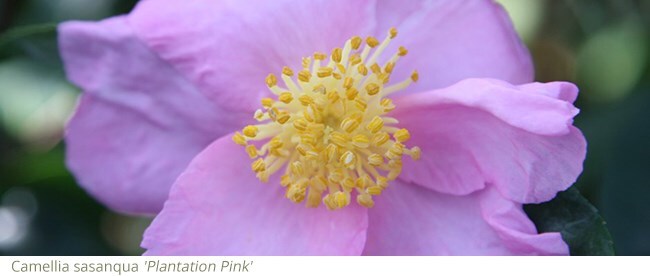
Most camellias need acid soil to do well. However the sasanquas, which flower between November and February, will tolerate good garden soil. They are found naturally in Southern Japan and have been grown in Japanese gardens for centuries as ornamentals and also for their oil. This is used in cooking, on the hair and for many other purposes. They are not highly frilly in form, like some camellias are. The Japanese admire sasanquas for their simplicity of form whether grown in temple gardens, or as miniature bonsai. Their ability to tolerate drought has made them highly popular plants throughout the world.
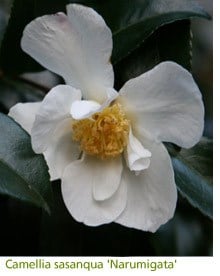 'Plantation Pink' is a robust variety, bearing lots of single pink flowers, while the historic 'Narumigata' has somewhat ruffled, single white flowers softened by hints of pink. Single-flowered forms are less frost-affected. 'Plantation Pink' is a robust variety, bearing lots of single pink flowers, while the historic 'Narumigata' has somewhat ruffled, single white flowers softened by hints of pink. Single-flowered forms are less frost-affected.
The sasanquas form large shrubs and are best planted in the garden, or in very large containers. Forms of C. japonica are best grown in ericaceous compost, in containers, because most garden soils are not acidic enough for them. Camellia flowers, especially the double frilly forms, brown if they thaw too quickly and for this reason camellias are best grown in areas that don't get morning sun. West-facing is usually the best aspect, although a sheltered north-facing position also works. 'Spring Festival', an early pink form with rose-like flowers, is grown all over the world. Or try the reliable red 'Adolphe Audusson' if you prefer stronger colours.
Finally make room for some double snowdrops, Galanthus nivalis 'Flore Pleno'. They may not be as elegant as the singles, but their frilly inner skirts ensure that they always look wide open - even on the dullest day.
|



